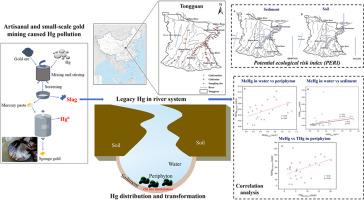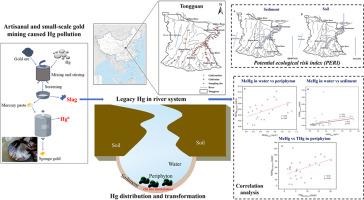历史上的手工采金对河流生态系统构成长期的汞风险——以中国西北潼关地区为例
IF 7.3
2区 环境科学与生态学
Q1 ENVIRONMENTAL SCIENCES
引用次数: 0
摘要
手工和小规模金矿开采(ASGM)实践是世界范围内汞(Hg)释放的重要历史来源,即使多年不活动也可能影响当地生态系统。本研究通过对潼关地区的水体、沉积物、周围植物和农田土壤的采样分析,评估了当前总汞(THg)和甲基汞(MeHg)水平,以及遗留汞对河流系统的潜在影响。结果表明,97%的沉积物和40%的土壤汞含量处于极高危水平,约32%的河流水样超过了中国地表水环境质量标准III类指导限值(100 ng/L)。沉积物中甲基汞的浓度甚至高于2006年的报道,这表明遗留的汞仍然可以甲基化并进一步释放。水体中MeHg与沉积物/周围植物的正相关表明,这些基质中原位甲基化是水系中MeHg的主要来源,而在石质河床的水系中,周围植物的作用比沉积物更重要。周边植物中MeHg的浓度和生物富集系数较高,对当地水生生物群造成了沉重的负担,并且由于MeHg通过水生食物网的生物富集和生物放大,可能给当地居民带来潜在的健康风险。此外,估计潼关水系每年向黄河输送THg 2.06 kg和MeHg 0.013 kg。该研究表明,即使在采矿活动停止近30年后,ASGM仍可能对河流生态系统造成长期的汞风险。本文章由计算机程序翻译,如有差异,请以英文原文为准。


Historical artisanal gold mining poses long-term risk of mercury to river ecosystems: A case study in Tongguan area of northwestern China
Artisanal and small-scale gold mining (ASGM) practice is an important historical source of mercury (Hg) release worldwide, which could affect the local ecosystem even after many years of inactivity. In this study, sampling and analysis of water, sediment, periphyton and nearby farmland soil were conducted to assess the current levels of total mercury (THg) and methylmercury (MeHg), and the potential impact of legacy Hg on river system in Tongguan, a typical historical ASGM area of northwestern China. Results showed that 97 % of sediments and 40 % of soils are at extremely high-risk level of Hg, and approximately 32 % of river water samples exceed the Class III guidance limit (100 ng/L of Hg) of the environmental quality standards for surface water in China. Concentration of MeHg in sediment was even higher than that reported in 2006, suggesting that legacy Hg can still be methylated and further released. Positive correlations between MeHg in water and sediment/periphyton indicated that in-situ Hg methylation in these matrices was the main source of MeHg in river system, while periphyton plays a more important role than sediment in this river system with rocky riverbeds. High concentration and bioaccumulation factor of MeHg were observed in periphyton, implying a substantial burden on local aquatic biota, which could pose potential health risks to local residents due to the bioaccumulation and biomagnification of MeHg through the aquatic food web. Besides, the river system in Tongguan was approximately estimated to transport 2.06 kg of THg and 0.013 kg of MeHg annually into the Yellow River. This study demonstrates that ASGM can pose a long-term risk of Hg to river ecosystem even after the mining activities ceased for nearly three decades.
求助全文
通过发布文献求助,成功后即可免费获取论文全文。
去求助
来源期刊

Environmental Pollution
环境科学-环境科学
CiteScore
16.00
自引率
6.70%
发文量
2082
审稿时长
2.9 months
期刊介绍:
Environmental Pollution is an international peer-reviewed journal that publishes high-quality research papers and review articles covering all aspects of environmental pollution and its impacts on ecosystems and human health.
Subject areas include, but are not limited to:
• Sources and occurrences of pollutants that are clearly defined and measured in environmental compartments, food and food-related items, and human bodies;
• Interlinks between contaminant exposure and biological, ecological, and human health effects, including those of climate change;
• Contaminants of emerging concerns (including but not limited to antibiotic resistant microorganisms or genes, microplastics/nanoplastics, electronic wastes, light, and noise) and/or their biological, ecological, or human health effects;
• Laboratory and field studies on the remediation/mitigation of environmental pollution via new techniques and with clear links to biological, ecological, or human health effects;
• Modeling of pollution processes, patterns, or trends that is of clear environmental and/or human health interest;
• New techniques that measure and examine environmental occurrences, transport, behavior, and effects of pollutants within the environment or the laboratory, provided that they can be clearly used to address problems within regional or global environmental compartments.
 求助内容:
求助内容: 应助结果提醒方式:
应助结果提醒方式:


